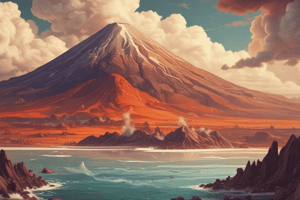Podcast
Questions and Answers
The Ring of Fire is a chain of volcanoes located only in the Atlantic Ocean.
The Ring of Fire is a chain of volcanoes located only in the Atlantic Ocean.
False (B)
Alfred Wegener's theory of land movement was widely accepted by scientists in 1912.
Alfred Wegener's theory of land movement was widely accepted by scientists in 1912.
False (B)
The Earth's surface is made up of only one enormous plate of rock.
The Earth's surface is made up of only one enormous plate of rock.
False (B)
The process of subduction always results in the creation of new volcanoes.
The process of subduction always results in the creation of new volcanoes.
The plates on the Earth's surface move at speeds of up to 100 kilometers per year.
The plates on the Earth's surface move at speeds of up to 100 kilometers per year.
Match the following scientists with their contributions to the field of plate tectonics:
Match the following scientists with their contributions to the field of plate tectonics:
Match the following features with their characteristics in the Ring of Fire:
Match the following features with their characteristics in the Ring of Fire:
Match the following terms with their definitions:
Match the following terms with their definitions:
Match the following processes with their effects on the Earth's surface:
Match the following processes with their effects on the Earth's surface:
Match the following regions with their location in the Ring of Fire:
Match the following regions with their location in the Ring of Fire:
Match the following geological features with their formation processes:
Match the following geological features with their formation processes:
Match the following rates with their corresponding geological processes:
Match the following rates with their corresponding geological processes:
Match the following components with their composition in the Earth's surface:
Match the following components with their composition in the Earth's surface:
Match the following terms with their descriptions:
Match the following terms with their descriptions:
Match the following geological processes with their effects on the Earth's surface:
Match the following geological processes with their effects on the Earth's surface:
Flashcards are hidden until you start studying
Study Notes
The Ring of Fire
- The Ring of Fire is a chain of volcanoes around the Pacific Ocean, stretching from New Zealand to Asia, across the ocean to Alaska, and down the coasts of North and South America.
- Over 75% of the world's volcanoes are located in the Ring of Fire.
Plate Tectonics
- In 1912, Alfred Wegener proposed the first theory of land movement, suggesting continents are made up of lighter rocks resting on heavier material.
- Wegener's idea was that the positions of the continents were not fixed, but moved slightly, similar to large objects floating on water.
- Later, scientists developed the theory of plate tectonics, which states that the Earth's surface consists of enormous plates or sections of rock, each about 80 km thick.
- These plates float and move slowly, at speeds of 1-10 cm per year, similar to the rate of fingernail growth.
Plate Movement and Subduction
- Within the Ring of Fire, new material is constantly being created as hot liquid rock (magma) flows from the Earth's center to the ocean floor.
- Existing plates on the Earth's surface move slightly to make room for the new material, causing them to move away from or towards each other.
- When plates collide, one plate may move under another, a process called subduction, which can cause earthquakes.
- Subduction can also result in the bottom plate melting due to extreme temperatures, resulting in the creation of magma that can rise to the surface and erupt through volcanoes.
The Ring of Fire
- The Ring of Fire is a massive chain of volcanoes surrounding the Pacific Ocean, spanning from New Zealand to Asia, then across the ocean to Alaska, and down the coast of North and South America.
- Over 75% of the world's volcanoes are located in the Ring of Fire.
Plate Tectonics
- In 1912, German scientist Alfred Wegener proposed the theory of land movement, suggesting that continents are composed of lighter rocks resting on heavier material.
- Wegener's idea was that continents move slightly, similar to large objects floating on water.
- Later, scientists developed the theory of plate tectonics, which states that the Earth's surface consists of enormous plates or sections of rock, approximately 80 kilometers thick.
- These plates float and move slowly, at speeds of 1-10 centimeters per year, equivalent to the rate of fingernail growth.
Plate Movement and Volcanic Activity
- Within the Ring of Fire, new material is constantly being created as hot liquid rock (magma) flows from the Earth's center to the ocean floor.
- Existing plates move to make room for the new material, causing them to collide and sometimes resulting in one plate moving under another (subduction).
- Subduction can cause earthquakes and may result in the melting of the bottom plate due to extreme temperatures.
- The magma created in this process can rise to the surface and erupt through volcanoes, as seen in the Ring of Fire.
Studying That Suits You
Use AI to generate personalized quizzes and flashcards to suit your learning preferences.



